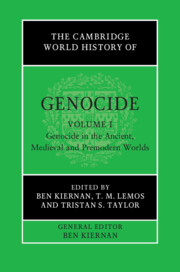Book contents
- The Cambridge World History of Genocide
- The Cambridge World History of Genocide
- The Cambridge World History of Genocide
- Copyright page
- Contents
- Figures
- Maps
- Tables
- Contributors to Volume I
- General Editor’s Acknowledgements
- General Editor’s Introduction to the Series
- Introduction to Volume I
- Part I Themes of Genocide through History
- 1 Genocide before the State?
- 2 The Religion–Genocide Nexus
- 3 Genocide and Gender
- 4 Genocide, Starvation and Famine
- 5 Climate, Violence and Ethnic Conflict in the Ancient World
- Part II The Ancient World
- Part III The Medieval World and Early Imperial Expansions
- Index
5 - Climate, Violence and Ethnic Conflict in the Ancient World
from Part I - Themes of Genocide through History
Published online by Cambridge University Press: 23 June 2023
- The Cambridge World History of Genocide
- The Cambridge World History of Genocide
- The Cambridge World History of Genocide
- Copyright page
- Contents
- Figures
- Maps
- Tables
- Contributors to Volume I
- General Editor’s Acknowledgements
- General Editor’s Introduction to the Series
- Introduction to Volume I
- Part I Themes of Genocide through History
- 1 Genocide before the State?
- 2 The Religion–Genocide Nexus
- 3 Genocide and Gender
- 4 Genocide, Starvation and Famine
- 5 Climate, Violence and Ethnic Conflict in the Ancient World
- Part II The Ancient World
- Part III The Medieval World and Early Imperial Expansions
- Index
Summary
The role of climate (including abrupt changes and extreme weather) in modern-era violence and conflict has received considerable attention in the past two decades from scholars in multiple fields, yet the mechanisms underlying (and even the reality of) such a role remains contested. Concern over projected climatic changes as a trigger for intensified violence, including mass killing and genocide, nonetheless continues to propel research. Data limitations are frequently cited as a challenge, yet comparatively few studies have turned to the millennia of human history documenting a broad range of violence against diverse social and environmental backgrounds. This chapter reviews evidence for ‘pathways’ by which climate may have contributed to violence and conflict in the Ancient Near East and Egypt. It emphasized religious, ideological, and ethnic dimensions that may have been catalysed by the psychological and material impacts of extreme weather to promote violence and conflict. In particular, we study state-enacted violence by the Neo-Assyrian Empire (909-611 BCE) and internal revolt in Ptolemaic Egypt (305-30 BCE). Newly available ice-core-based dates of explosive volcanism allow the examination of societal responses to the ensuing hydroclimatic shocks (also potentially ‘ominous’ volcanic dust-veils). These can be shown to closely precede documented increases in violence and conflict, including external warfare and internal revolt.
Keywords
- Type
- Chapter
- Information
- The Cambridge World History of Genocide , pp. 150 - 182Publisher: Cambridge University PressPrint publication year: 2023
- 2
- Cited by



